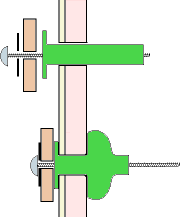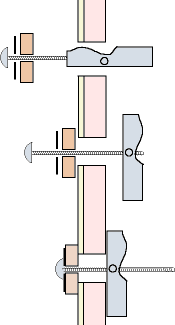Wall fixings for hollow surfaces
Fixings for hollow structures (walls, ceilings and doors etc.)
and how to use them
When fixing onto any surface the strength of the fixing is always dependent upon the strength of the actual surface, with hollow surfaces this is generally less than for a solid structure.
It is always best with hollow surfaces to try to locate and fix into one of the support members.
This is not always possible and it is sometimes necessary to actually secure onto the covering, be it plaster board, hardboard or whatever.
When drilling relatively thin, soft materials it is not necessary or desirable to use hammer action if a power drill is used.
Before drilling into any void, check for possible concealed pipes and electric wiring.
Rubber-sleeved fixing with captured insert
 As the screw is tightened into the rubber sleeve inserted through the wallboard, the sleeve is compressed against the reverse side of wall. The screw can be removed/replaced if required, the fixing will remain in place through the wall.
As the screw is tightened into the rubber sleeve inserted through the wallboard, the sleeve is compressed against the reverse side of wall. The screw can be removed/replaced if required, the fixing will remain in place through the wall.
After the required hole is drilled, the rubber sleeve is inserted through the covering; the sleeve needs to be a fairly tight fit through the hole to ensure that it does not rotate when the screw is tightened. The screw is then inserted through the workpiece and into a tapped insert, which is moulded into the back end of the sleeve.
The sleeve has a small rim which stands proud of the outer surface, to allow the workpiece to sit flat against the surface, the back of the workpiece should be relieved around the hole.
Various sizes are available; the screws are supplied with the fitting although longer screws of the appropriate diameter/thread can be used where the workpiece is too thick for the screw supplied.
Plastic collapsible fixing
 Very similar to the above fixing but using an ordinary wood screw. The fixing is used in the same manner as the above but they tend to stand up less well to repeated screw removal/replacement as the screw tends to cut a new thread each time it is inserted.
Very similar to the above fixing but using an ordinary wood screw. The fixing is used in the same manner as the above but they tend to stand up less well to repeated screw removal/replacement as the screw tends to cut a new thread each time it is inserted.
Plastic spread fixing
 An inexpensive fixing which is not reusable - removal of the screw will result in the fixing dropping down the cavity.
An inexpensive fixing which is not reusable - removal of the screw will result in the fixing dropping down the cavity.
Drill a hole just large enough to take the head of the fixing.
An ordinary wood screw of the appropriate length (at least equal to the thickness of the workpiece plus the thickness of wallboard plus the length of the fixing), is inserted through the workpiece and into the fixing by about 2 or 3 turns. The fixing is then pushed through the hole in the wallboard. As the fixing is pushed through, the 'legs' of the fixing are compressed and they spring out once the fixing is through the board. The workpiece needs to be pulled away from the front surface so that the legs of the fixings bear on the reverse side of the wall as the screw is tightened.
Various sizes are available to suit various diameters of wood screw.
Spring metal toggle fixing
 These fixings tend to give a stronger anchor than the plastic types above as they spread the load over a larger area on the reverse side of wallboard. The fixing consists of two spring-loaded metal arms with a thread tapped into the hinge pivot. The two arms are held against the screw as the fixing is inserted through the pre-drilled hole and then spring out to spread the load on the reverse side of the wallboard. The fixings cannot be reused - removal of the screw will result in the fixing dropping down the cavity.
These fixings tend to give a stronger anchor than the plastic types above as they spread the load over a larger area on the reverse side of wallboard. The fixing consists of two spring-loaded metal arms with a thread tapped into the hinge pivot. The two arms are held against the screw as the fixing is inserted through the pre-drilled hole and then spring out to spread the load on the reverse side of the wallboard. The fixings cannot be reused - removal of the screw will result in the fixing dropping down the cavity.
Drill a hole just large enough to allow the toggle to be pushed through with its spring-loaded arms held together.
Pass the fixing screw through the workpiece into toggle. Push the toggle through the hole until the arms spring out, pull the workpiece away from the front surface (so that the arms bear against the reverse side of the wallboard) and tighten the screw.
Various sizes are available; the screws are supplied with the fitting although longer screws of the appropriate diameter/thread can be used where the workpiece is too thick for the screw supplied.
Gravity metal toggle fixing
 These fixings are similar to the spring type above except that the toggle is made in one piece which is passed through the hole and then drops down under gravity to be parallel to a vertical wallboard. These fixings can only be used when fixing to vertical surfaces. The fixings cannot be reused - removal of the screw will result in the toggle dropping down the cavity.
These fixings are similar to the spring type above except that the toggle is made in one piece which is passed through the hole and then drops down under gravity to be parallel to a vertical wallboard. These fixings can only be used when fixing to vertical surfaces. The fixings cannot be reused - removal of the screw will result in the toggle dropping down the cavity.
Drill hole just big enough to allow the toggle to be passed through when the toggle is parallel to the fixing screw.
Pass the fixing screw through the workpiece into toggle. Push the toggle through the hole until it turns within the cavity, pull the workpiece away from the front surface (so that the toggles bear against the reverse side of the wallboard) and tighten the screw.
Various sizes are available; the screws are supplied with the fitting although longer screws of the appropriate diameter/thread can be used where the workpiece is too thick for the screw supplied.
fixings for: solid surfaces
